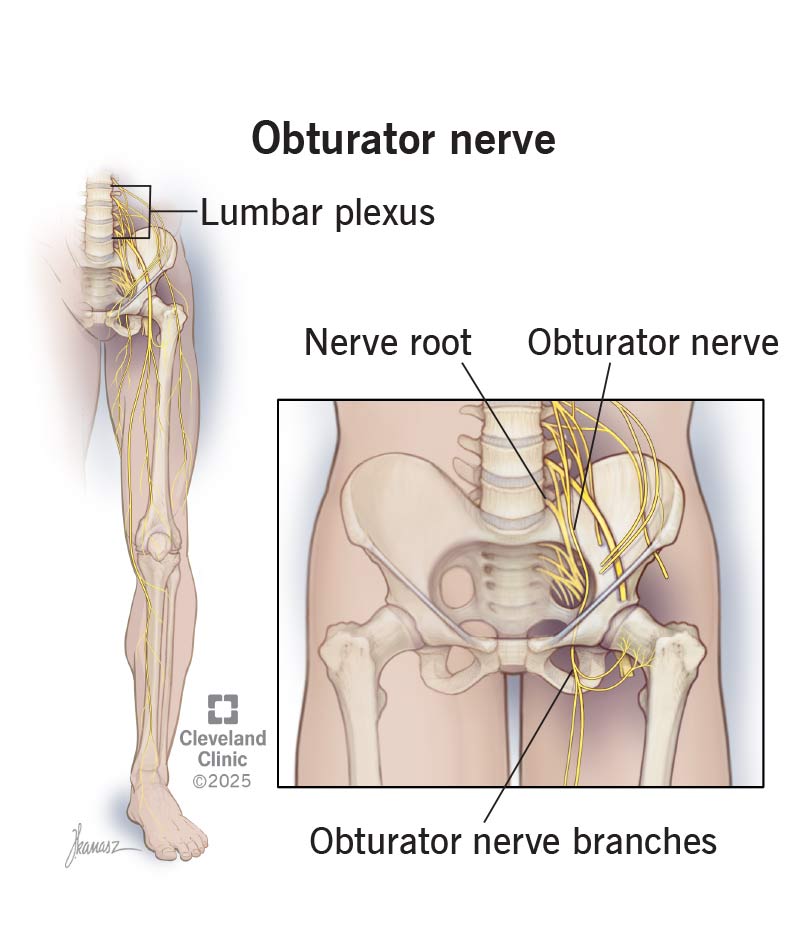Your obturator nerve helps you move and feel your inner thigh. It starts in your lower back and travels through your groin. Accidents, sports injuries and childbirth can injure this nerve. It may cause pain, numbness and muscle weakness. A healthcare provider can help you take care of this nerve.
Advertisement
Cleveland Clinic is a non-profit academic medical center. Advertising on our site helps support our mission. We do not endorse non-Cleveland Clinic products or services. Policy

Your obturator nerve carries signals that help your inner thigh feel and move. This nerve is part of your peripheral nervous system (PNS). The PNS helps your brain send messages to the rest of your body.
Advertisement
Cleveland Clinic is a non-profit academic medical center. Advertising on our site helps support our mission. We do not endorse non-Cleveland Clinic products or services. Policy
This nerve starts in a group of nerves in your lower back called the lumbar plexus. The group lets you move and feel your upper and lower legs and feet. It’s one of many nerves that pass through your groin as they travel down to communicate with your inner thigh.
This nerve provides movement (motor functions) and feeling (sensory functions) to your inner thigh.
Muscles along your obturator nerve help you:
This nerve provides feeling to:
Nerve roots branch off your spine. The nerve roots that make up your obturator nerve (as well as other nerves) come from the L2, L3 and L4 levels of your lumbar spine. These nerve roots come together from the lumbar plexus. The obturator nerve is a branch off of the lumbar plexus in your lower back.
From there, the nerve travels a long path:
Advertisement
Once it passes through your groin, it branches out.
When your obturator nerve reaches your upper thigh, it splits into three main branches:
Sometimes, the anterior branch also helps move a muscle in your upper inner thigh called the pectineus. Usually, your femoral nerve controls this muscle. But in some people, the obturator nerve helps instead. This is a normal variation.
The following muscles receive nerve signals from (are innervated by) the obturator nerve:
An obturator nerve injury happens when there’s damage to the nerve itself. It could cause pain, numbness or tingling in your groin or thigh. It could even cause weakness when you bring your thigh toward the middle (adduction).
It may happen with the following conditions:
Because your pelvis has many important structures packed into a small space, your obturator nerve can sometimes be at risk during procedures. Surgeons are highly trained to work carefully in this area. Still, in rare cases, pressure or stretching can injure the nerve.
Advertisement
Before your procedure, your provider will talk with you about these risks so you know what to expect.
Childbirth can also affect this nerve. Moving your legs away from your body during delivery can put extra pressure or stretch on the nerve.
If a side effect or injury happens, your provider will offer treatments to help you feel better.
A nerve block is when a healthcare provider injects a medication to numb the nerve so you don’t feel sensations from it. Your provider may need to:
Contact a healthcare provider if you notice:
You probably haven’t thought much about your obturator nerve until something feels off. That’s completely normal. Most people don’t even know this nerve exists until pain or discomfort makes it impossible to ignore. While problems with this nerve can be uncomfortable, they’re not uncommon. The good news is that your healthcare provider can diagnose what’s wrong and offer treatments to help you feel better.
Advertisement
If you have a neurological condition, you want expert advice. At Cleveland Clinic, we’ll work to create a treatment plan that’s right for you.

Last reviewed on 08/27/2025.
Learn more about the Health Library and our editorial process.